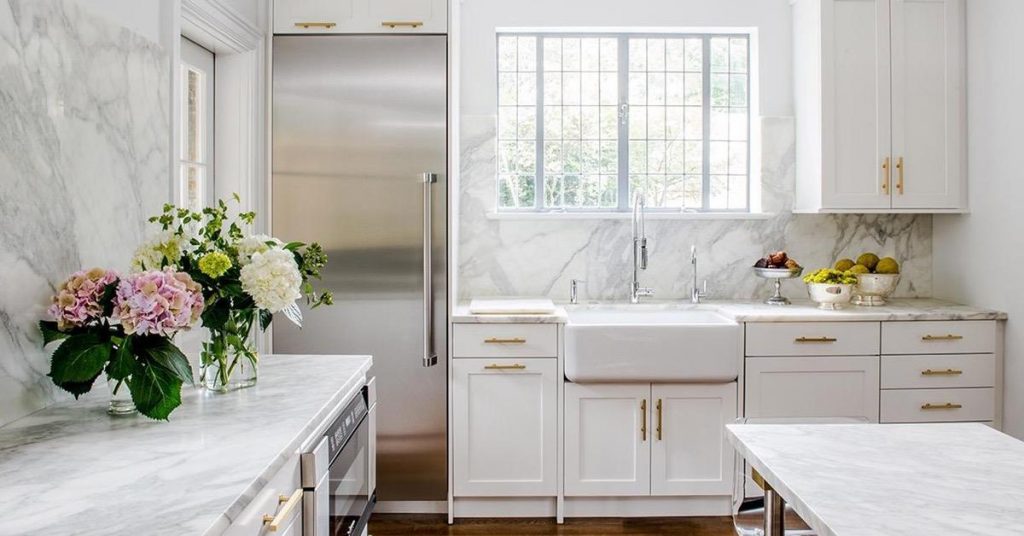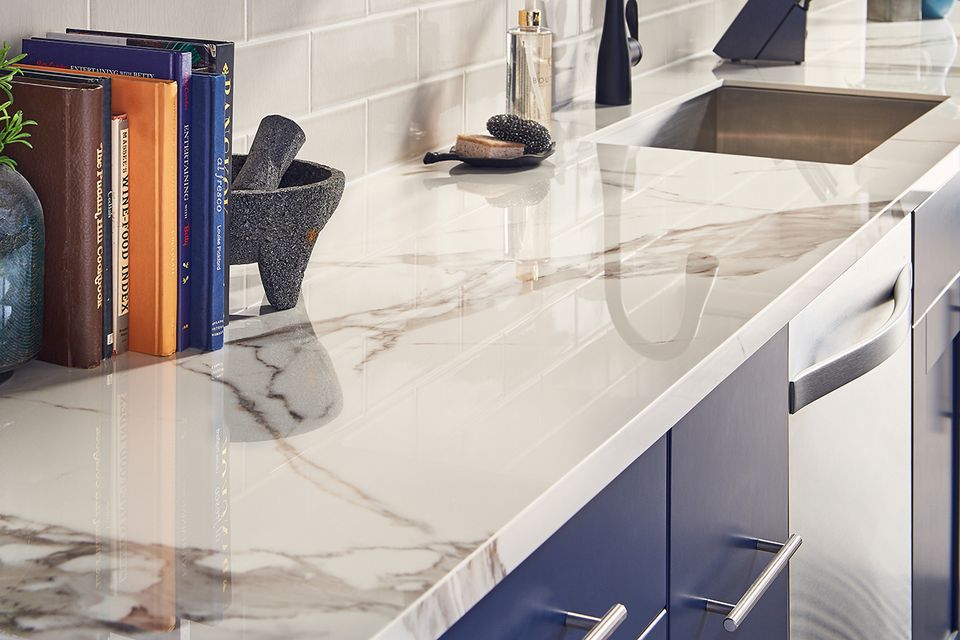If your kitchen is a busy location filled with activity: baking, cooking, and amusing, you want a countertop that can hold up against the wear and tear of everyday use.
When consumers are taking a look at brand-new kitchen area countertop materials, we are typically asked 2 concerns: “Can I place hot pots and pans directly on my countertops?” and “Can I cut food straight on top of the counters?”
While there are many long lasting alternatives for cooking area counters, not all products respond well to heat and sharp items. Check out listed below for more details!
Currently have a scratch or a scorch mark in your counter tops? Speak with one of our advised stone and countertop repair experts!
Quartz Countertops
Cambria Roxwell on a big kitchen area island.
Cambria, Silestone, Pental Quartz, HanStone, and Caesarstone all say NO to hot pots and pans because of thermal shock. Thermal shock is the phenomenon where a cold surface is heated at an exceptionally quick rate, causing the material to fracture.
Blistering or burning the surface area isn’t the issue; Silestone even says “don’t worry about dropping a lit match onto your Silestone counter top; it will not blister.” However due to the danger of thermal shock, all quartz producers advise that you use a trivet or hot pad under hot pots and pans.
All of the noted quartz makers likewise alert against cutting food directly on the counter, as while they’re extremely scratch-resistant, they’re not scratch-proof. And on a smooth, solid-color quartz surface area, scratches are going to be more noticeable than on a greatly textured or patterned surface area.

Granite Counter tops
Alaska White granite on the island of a kitchen with dark cabinets.
Granite is a granular igneous rock, and one of the most popular options for kitchen area countertops. However considering that it is a natural stone composite of several minerals, it too goes through thermal shock and can break, especially close to edges or overhangs. Consistently setting hot pans in one area will deteriorate it and it could eventually split.
The granite won’t swelter, but the heat can deteriorate or blemish the sealant used on the granite, or transfer the sealant to the bottoms of hot pots and pans (leaving staining). We have actually likewise become aware of people setting the wax paper with hot, fresh-from-the-oven cookies on their granite, just for the cookies to leave little dark “shadows” of wax paper embedded in the pores of the granite.
We suggest using trivets or hot pads with granite to decrease the threat of destroying the sealant or triggering thermal shock.
Because of its permeable nature, food preparation directly on unsealed granite could leave bacteria in the granite. Likewise, granite, while far more powerful than marble and other stones, is still prone to scratching. However, scratches might be less visible on granite than quartz because of the natural fissures and flecks in granite’s surface area. We recommend using cutting boards on granite.
Marble Countertops
A white marble counter top with brown veins on a dark wood island. the side cabinets are white with white counter tops. There are large orange copper pendant lights above the island.
We typically don’t recommend marble for kitchen area counter tops, as this calcium-based stone can be rapidly damaged and engraved by acids in the fruit, vinegar, juice, or other typical kitchen area products.
A softer natural stone, marble is extremely vulnerable to scratches. This, combined with its acid-sensitivity, means that it should not be used as a prep surface area for most foods (marble has, however, been used as an excellent baking surface for centuries, and some homeowners will keep a marble block specifically for rolling out dough).
Marble is most likely to break due to thermal shock than quartz or granite, and as such, you must not set hot pots or pans straight on marble.
If you like the look of marble, consider quartz counter tops. There are now lots of quartz slabs developed to appear like marble without the maintenance problems.
Soapstone Countertops
Soapstone island with a large piece of butcher block on it in the middle of a modern-day kitchen area.
Soapstone is both chemical resistant and heat resistant, so you can set hot pots and pans directly on soapstone without threat of breaking or burning. Soapstone is much softer and more prone to scratching than granite or quartz however, so preparing food straight on your soapstone counters might quickly scratch it.
Corian Countertops
Light cream-colored Corian counter top and backsplash with sage green painted cabinets and walls.
Dupont advises that you use hot pads or trivets on your Corian, and due to its softer composition, you could easily scratch it if you prepared food on top of it (bacterial growth is not an issue due to Corian’s non-porous nature). Use a cutting board.
Laminate Countertops
Veined sandy-colored Formica countertops with red wine glasses and a flower vase.
Formica says to constantly use hot pads or trivets with Laminate: the glue might stop working, causing it to peel or separate, and you might scorch the surface area.
Use a cutting board to prevent scratching your Laminate.
Butcher Block
Rustic style cooking area with medium brown wood cabinets, bronze door pulls, black quartz counter tops, and a butcher block island top.
Pair a Caribou wood island countertop with a sleek quartz countertop on your perimeter cabinets for an abundant style.
Butcher block is particularly suggested for food prep, and as such you only require to use a cutting board over it if you bought it for appearances and wish to keep it’s look. However, to prevent contamination and health hazards just cut vegetables and fruits on your butcher block, and have a loose, different cutting board for meat.
Because it is wood, placing hot pots and pans on it might quickly scorch it or leave burn marks. The oils utilized to finish your butcher block might also cook and be tarnished by the extreme heat.
Upkeep on butcher block counters is a labor of love, however, so take that into consideration when looking at this counter choice.
Sintered surface areas such as Dekton and Lapitec are a fusion of quartz, glass, and porcelain into a nigh-indestructible surface area.
You can set hot pots on sintered surface areas without issue, because the blend of materials is so tight and strong.
You can prepare food straight on sintered surface areas without scratching them; however, you will dull your knives if you cut food straight on these countertops.
However, these surface areas are extremely expensive compared to other countertop types. Due to the fact that they are so thick, they take a lot longer to cut and fabricate, increasing production time and expense.
In Conclusion …
Kitchen with white cabinets, black counter top, and backsplash, and red pots on the stove.
The only counter top materials that you can securely set hot pots and pans on are Soapstone and sintered surfaces; in fact, they are suggested as counter top materials for that function.
Setting best-sellers straight on quartz or granite might not damage them right away, but they could eventually break due to thermal shock.
Marble, Corian, and Laminate are all far too delicate for direct contact with hot pots or even some heated devices (electrical kettles, waffle makers, and so on).
Open kitchen cabinet drawers with knives, cutting boards, and cut red cabbage.
Can you utilize your counter top as a cutting board? If it’s butcher block, then yes! Understand that it will require regular maintenance and that the butcher block will scratch and show signs of wear.
You can cut food on sintered surfaces without damaging them, however it will dull your knives, so it’s better to use a cutting board.
You can likewise cut food on quartz, simply know that scratch-resistant is not scratch-proof, and you might possibly scratch your quartz. We do not advise cutting food straight on granite, marble, soapstone, Corian, or Laminate.

